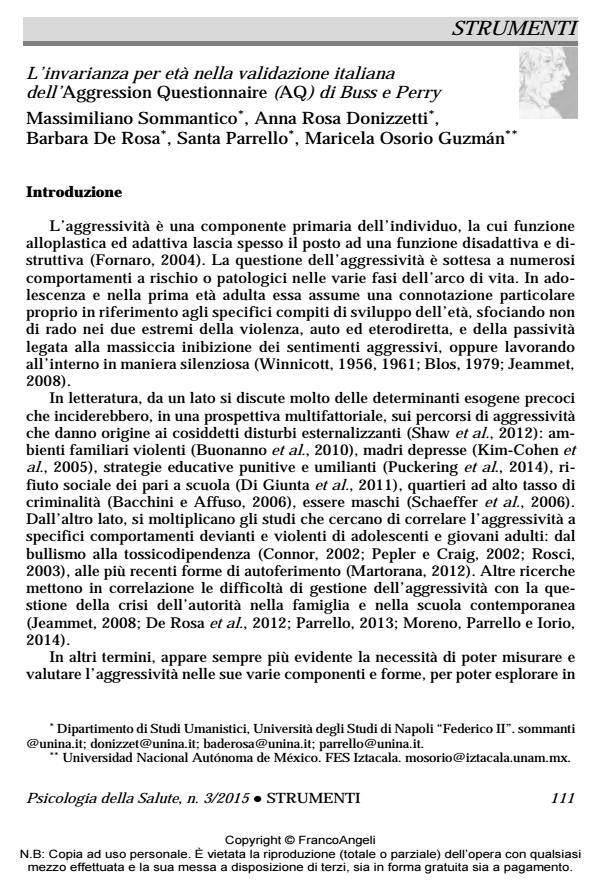L’invarianza per età nella validazione italiana dell’Aggression Questionnaire (AQ) di Buss e Perry
Titolo Rivista PSICOLOGIA DELLA SALUTE
Autori/Curatori Massimiliano Sommantico, Anna Rosa Donizzetti, Barbara DeRosa, Santa Parrello, Guzman Maricela Osorio
Anno di pubblicazione 2015 Fascicolo 2015/3
Lingua Italiano Numero pagine 15 P. 111-125 Dimensione file 105 KB
DOI 10.3280/PDS2015-003006
Il DOI è il codice a barre della proprietà intellettuale: per saperne di più
clicca qui
Qui sotto puoi vedere in anteprima la prima pagina di questo articolo.
Se questo articolo ti interessa, lo puoi acquistare (e scaricare in formato pdf) seguendo le facili indicazioni per acquistare il download credit. Acquista Download Credits per scaricare questo Articolo in formato PDF

FrancoAngeli è membro della Publishers International Linking Association, Inc (PILA)associazione indipendente e non profit per facilitare (attraverso i servizi tecnologici implementati da CrossRef.org) l’accesso degli studiosi ai contenuti digitali nelle pubblicazioni professionali e scientifiche
La questione dell’aggressività, quale componente primaria dell’individuo, è sottesa a numerosi comportamenti a rischio nelle diverse fasi dell’arco di vita. È sempre più evidente la necessità di poter misurare e valutare l’aggressività nelle sue varie componenti e forme per esplorare in maniera appropriata i diversi comportamenti ed emozioni che intralciano i percorsi di salute e benessere. L’Aggression Questionnaire (AQ, Buss e Perry, 1992) sembra essere ancor oggi uno degli strumenti maggiormente utilizzati nella valutazione di diversi livelli di aggressività in differenti epoche della vita. L’obiettivo principale del presente lavoro è stato quello di fornire un ulteriore apporto alla validazione italiana di questo strumento, indagando l’invarianza della struttura fattoriale in due diverse fasce d’età: adolescenti/tardo adolescenti (N = 319) e giovani (N = 417). I risultati sono stati molto soddisfacenti considerando la verifica sia separata che simultanea del modello nei due gruppi d’età. Indagini future dovrebbero approfondire le specificità contestuali dello strumento.
Parole chiave:Aggression Questionnaire, invarianza per età, validazione, generalizzabilità
- Teaching in the Suburbs: Participatory Action Research Against Educational Wastage Santa Parrello, Ilaria Iorio, Filomena Carillo, Cesare Moreno, in Frontiers in Psychology 2308/2019
DOI: 10.3389/fpsyg.2019.02308 - Family religiosity and climate: the protective role of personal interiorized religiosity in deviance propensity among justice-involved juveniles Valeria Saladino, Oriana Mosca, Cristina Cabras, Valeria Verrastro, Marco Lauriola, in Frontiers in Psychology 1197975/2024
DOI: 10.3389/fpsyg.2024.1197975 - Is Family Structure Associated with Deviance Propensity during Adolescence? The Role of Family Climate and Anger Dysregulation Valeria Saladino, Oriana Mosca, Marco Lauriola, Lilli Hoelzlhammer, Cristina Cabras, Valeria Verrastro, in International Journal of Environmental Research and Public Health /2020 pp.9257
DOI: 10.3390/ijerph17249257 - Italian university students’ future time perspective and well-being during the COVID-19 pandemic Santa Parrello, Jacopo Postiglione, Luigia Simona Sica, Barbara De Rosa, Anna Parola, Giorgio Maria Regnoli, Elisabetta Fenizia, Massimiliano Sommantico, in Frontiers in Psychology 1404952/2024
DOI: 10.3389/fpsyg.2024.1404952
Massimiliano Sommantico, Anna Rosa Donizzetti, Barbara DeRosa, Santa Parrello, Guzman Maricela Osorio, L’invarianza per età nella validazione italiana dell’Aggression Questionnaire (AQ) di Buss e Perry in "PSICOLOGIA DELLA SALUTE" 3/2015, pp 111-125, DOI: 10.3280/PDS2015-003006